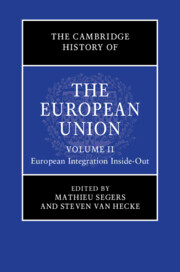Book contents
- The Cambridge History of the European Union
- The Cambridge History of the European Union
- The Cambridge History of the European Union
- Copyright page
- Contents
- Figures
- Tables
- Contributors to Volume II
- Acknowledgements
- Abbreviations
- Reflections on the History and Historiography of European Integration
- Part I Milestones: Treaties and Treaty Changes
- Part II Instruments of Integration
- Part III Narratives and Outcomes
- War and Peace
- 16 A Global Perspective on European Cooperation and Integration since 1918
- 17 War, Peace and Memory: Franco-German Reconciliation
- 18 The ‘Saints’ of European Integration: From Visionaries to Architects
- Prosperity and Solidarity
- Democracy and Legitimacy
- Index
- References
16 - A Global Perspective on European Cooperation and Integration since 1918
from War and Peace
Published online by Cambridge University Press: 12 October 2023
- The Cambridge History of the European Union
- The Cambridge History of the European Union
- The Cambridge History of the European Union
- Copyright page
- Contents
- Figures
- Tables
- Contributors to Volume II
- Acknowledgements
- Abbreviations
- Reflections on the History and Historiography of European Integration
- Part I Milestones: Treaties and Treaty Changes
- Part II Instruments of Integration
- Part III Narratives and Outcomes
- War and Peace
- 16 A Global Perspective on European Cooperation and Integration since 1918
- 17 War, Peace and Memory: Franco-German Reconciliation
- 18 The ‘Saints’ of European Integration: From Visionaries to Architects
- Prosperity and Solidarity
- Democracy and Legitimacy
- Index
- References
Summary
European integration as the solution that brought peace and democracy after the devastating wars ravaging Europe in the early twentieth century: this is still one of the most widespread narratives about European cooperation. It is, and was, also the pivot of the discourse of the European Union (EU) and its predecessors to justify their existence and create their success in a bold form of self-fashioning.1 Just like the German Stunde Null (zero hour) and the international caesura that the United Nations emphasised between itself and the League of Nations, European cooperation projects after the Second World War emphasised the novelty of their endeavours and the break with the preceding, violent era.
- Type
- Chapter
- Information
- The Cambridge History of the European Union , pp. 459 - 480Publisher: Cambridge University PressPrint publication year: 2023

